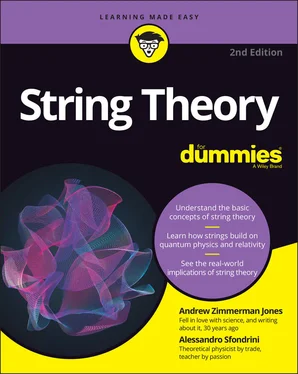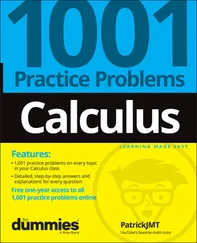In this chapter, you see some of the major successes and failures of string theory, as well as look at the possibilities for where string theory may go from here. The controversy over string theory rests entirely on how much significance physicists give to these different outcomes.
Celebrating String Theory’s Successes
String theory has gone through many transformations since its origins in 1968, when theorists hoped it would be a model of certain types of particle collisions. It initially failed at that goal, but in the 50 years since, string theory has developed into the primary candidate for a theory of quantum gravity. It has driven major developments in mathematics, and theorists have used insights from string theory to tackle other, unexpected problems in physics. In fact, the very presence of gravity within string theory is an unexpected outcome!
Predicting gravity out of strings
The first and foremost success of string theory is the unexpected discovery of objects within the theory that match the properties of the graviton. These objects are a specific type of closed strings that are also massless particles that have a spin of 2, exactly like gravitons. To put it another way, gravitons are a spin-2 massless particle that, under string theory, can be formed by a certain type of vibrating closed string. String theory wasn’t created to have gravitons — they’re a natural and required consequence of the theory.
One of the greatest problems in modern theoretical physics is that gravity seems to be disconnected from all the other forces of physics that are explained by the Standard Model of particle physics. String theory solves this problem because it not only includes gravity but makes gravity a necessary by-product of the theory.
Explaining what happens to a black hole (sort of)
A major motivating factor for the search for a theory of quantum gravity is to explain the behavior of black holes, and string theory appears to be one of the best methods of achieving that goal. String theorists have created mathematical models of black holes that appear similar to predictions made by Stephen Hawking more than 50 years ago and may be at the heart of resolving a long-standing puzzle within theoretical physics: What happens to matter that falls into a black hole?
Scientists’ understanding of black holes has always run into problems, because to study the quantum behavior of a black hole, you need to somehow describe all the quantum states (possible configurations, as defined by quantum physics) of the black hole. Unfortunately, black holes are objects in general relativity, so it’s not clear how to define these quantum states. (See Chapter 2for an explanation of the conflicts between general relativity and quantum physics.)
 String theorists have created models that appear to be identical to black holes in certain simplified conditions, and they use that information to calculate the quantum states of black holes. Their results have been shown to match Hawking’s predictions, which he made without any precise way to count the quantum states of a black hole.
String theorists have created models that appear to be identical to black holes in certain simplified conditions, and they use that information to calculate the quantum states of black holes. Their results have been shown to match Hawking’s predictions, which he made without any precise way to count the quantum states of a black hole.
This is the closest that string theory has come to an experimental prediction. Unfortunately, there’s nothing experimental about it because scientists can’t directly observe black holes to this level of detail. It’s a theoretical prediction that unexpectedly matches another (well-accepted) theoretical prediction about black holes. And, beyond that, the prediction only holds for certain types of black holes and hasn’t yet been successfully extended to all black holes.
For a more detailed look at black holes and string theory, check out Chapters 9, 13, and 16.
Explaining quantum field theory using string theory
One of the major successes of string theory is something called the Maldacena conjecture, or the AdS/CFT correspondence . (We get into what this means in Chapter 13.) Developed in 1997 and later expanded, this correspondence appears to give insights into gauge theories, like those at the heart of quantum field theory, and their relation to gravity. (See Chapter 2for an explanation of gauge theories.)
The original AdS/CFT correspondence, written by Juan Maldacena, argues that strings (that is, quantum gravity) in certain D -dimensional universes are equivalent to certain quantum field theories (without gravity) in a (D-1)- dimensional universe. This sounds confusing (it is), but in a nutshell, it means that quantum gravity is a bit like the Standard model (but for a universe in one dimension less), and the Standard model is a bit like quantum gravity (but for a universe in one dimension more). This is a very surprising way to think about quantum gravity (first anticipated by Nobel laureate Gerard ’t Hooft), which finds its most precise realization in Maldacena’s AdS/CFT correspondence.
More precisely, Maldacena proposed that a certain 3-dimensional (three space dimensions, like our universe) gauge theory, with the most supersymmetry allowed, describes the same physics as a string theory in a 4-dimensional (four space dimensions) world. This means that questions about string theory can be asked in the language of gauge theory, which is a quantum theory that physicists know how to work with!
String theory keeps making a comeback
String theory has suffered more setbacks than probably any other scientific theory in human history, but those hiccups don’t seem to last very long. Every time it seems that some flaw in the theory comes along, the mathematical resiliency of string theory seems to not only save it, but bring it back stronger than ever.
When extra dimensions came into the theory in the 1970s, string theory was abandoned by many, but it had a comeback in the first superstring revolution. It then turned out that there were five distinct versions of string theory, but a second superstring revolution was sparked by unifying them. When string theorists realized a vast number of solutions to string theories (each solution to string theory is called a vacuum, while many solutions are called vacua ) were possible, they turned this into a virtue instead of a drawback.
Still, even after so many years, some scientists believe that string theory is failing at its goals. (See “ Considering String Theory’s Setbacks” later in this chapter.)
Being the most popular theory in town
Many young physicists feel that string theory, as the primary theory of quantum gravity, is the best (or only) avenue for making a significant contribution to our understanding of this topic. Over the last three decades, high-energy theoretical physics (especially in the United States) has become dominated by string theorists. In the high-stakes world of “publish-or-perish” academia, this is a major success.
Why do so many physicists turn toward this field when it offers no experimental evidence? Some of the brightest theoretical physicists of either the 20th or the 21st centuries — Edward Witten, John Henry Schwarz, Leonard Susskind, and others you meet throughout this book — continually return to the same common reasons in support of their interest:
If string theory were wrong, it wouldn’t provide the rich structure that it does, such as with the development of the heterotic string (see Chapter 10), which allows for an approximation of the Standard Model of particle physics within string theory.
If string theory were wrong, it wouldn’t lead to better understanding of quantum field theory, quantum chromodynamics (see Chapter 8), or the quantum states of black holes, as presented by the work of Leonard Susskind, Andrew Strominger, Cumrun Vafa, and Juan Maldacena (see Chapters 11, 13, and 16).
Читать дальше

 String theorists have created models that appear to be identical to black holes in certain simplified conditions, and they use that information to calculate the quantum states of black holes. Their results have been shown to match Hawking’s predictions, which he made without any precise way to count the quantum states of a black hole.
String theorists have created models that appear to be identical to black holes in certain simplified conditions, and they use that information to calculate the quantum states of black holes. Their results have been shown to match Hawking’s predictions, which he made without any precise way to count the quantum states of a black hole.










